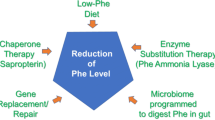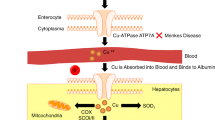Abstract
A 4-year-old patient is described with hyperphenylalaninemia, severe retardation in development, severe muscular hypotonia of the trunk and hypertonia of the extremities, convulsions, and frequent episodes of hyperthermia without infections. Urinary excretion of neopterin, biopterin, pterin, isoxanthopterin, dopamine, and serotonin was very low, although the relative proportions of pterins were normal. In lumbar cerebrospinal fluid, homovanillic acid, 5-hydroxy-indoleacetic acid, neopterin and biopterin were low. Oral administration ofL-erythro tetrahydrobiopterin normalized the elevated serum phenylalanine within 4 h, serum tyrosine was increased briefly and serum alanine and glutamic acid for a longer time. Urinary dopamine and serotonin excretion were also increased. Administration of an equivalent dose ofd-erythro tetrahydroneopterin was ineffective and demonstrated that this compound is not a cofactor in vivo and cannot be transformed into an active cofactor.
GTP cyclohydrolase I activity was not detectable in liver biopsies from the patient. The presence of an endogenous inhibitor in the patient's liver was excluded. This is the first case of a new variant of hyperphenylalaninemia in which the formation of dihydroneopterin triphosphate and its pterin metabolites in liver is markedly diminished. Normal activities of xanthine oxidase and sulfite oxidase were apparent since uric acid levels were normal and no increase in hypoxanthine, xanthine, andS-sulfocysteine concentrations could be observed in urine. It is concluded that the molybdenum cofactor of these enzymes may not be derived from dihydroneopterin triphosphate in man. Also, since no gross abnormalities in the patient's immune system could be found, it seems unlikely that dihydroneopterin triphosphate metabolites, such as neopterin, participate actively in immunological processes, as postulated by others. See Note added in proof.
Similar content being viewed by others
References
Arai N, Narisawa K, Hayakawa H, Tada K (1982) Hyperphenylalaninemia due to dihydropteridine reductase deficiency: Diagnosis by enzyme assays on dried blood spots. Pediatrics 70:426–430
Bartholomé K, Byrd DJ, Kaufman S, Milstien S (1977) Atypical phenylketonuria with normal phenylalanine hydroxylase and dihydropteridine reductase activity in vitro. Pediatries 59:757–761
Beck B, Brandt NJ, Christensen E, Niederwieser A, Pedersen PS (1983) Diagnostic and therapeutic aspects of dihydrobiopterin deficiency. Acta Paediatr Scand 72:449–454
Blau N, Niederwieser A (1983) GTP-cyclohydrolase I assay in human and rat liver using high-performance liquid chromatography of neopterin phosphates and guanine nucleotides. Anal Biochem 128:446–452
Blau N, Bosshard R, Redweik U, Niederwieser A (1982) HPLC of neopterin phosphates. Application to the study of GTP-cyclohydrolases. In: Wachter H, Curtius H-Ch, Pfleiderer W (eds) Biochemical and clinical aspects of pteridines, vol I. W. de Gruyter, Berlin, pp 103–116
Curtius H-Ch, Farner H, Rey F (1980) In vivo studies of the tryptophan 5-hydroxylase system. Quantitation of serotonin and tryptamine using gas chromatography-mass fragmentography. J Chromatogr 199:171–179
Curtius H-Ch, Wolfensberger M, Steinmann B, Redweik U, Siegfried J (1974) Mass fragmentography of dopamine and 6-hydroxydopamine. Application to the determination of dopamine in human brain biopsies from the caudate nucleus. J Chromatogr 99:529–540
Curtius H-Ch, Häusermann M, Heintel D, Niederwieser A, Levine RA (1983) Chemistry and biology of pteridines. In: Blair JA (ed) Pteridines and folic acid derivatives. W. de Gruyter, Berlin, pp 765–770
Danks DM, Bartholomé K, Clayton BE, Curtius H-Ch, Gröbe H, Kaufman S, Leeming R, Pfleiderer W, Rembold H, Rey R (1978) Malignant hyperphenylalaninaemia — Current status (June 1977). J Inherited Metab Dis 1:49–53
Duran M, Beemer FA, v d Heiden C, Korteland J, de Bree PK, Brink M, Wadman SK, Lombeck I (1978) Combined deficiency of xanthine oxidase and sulphite oxidase: A defect of molybdenum metabolism or transport. J Inherited Metab Dis 1:175–178
Fukishima K, Richter WE Jr, Shiota T (1977) Partlal purification of 6-D-erythro-1′,2′,3′-trihydroxypropy)-7,8-dihydropterin triphosphate synthetase from chicken liver. J Biol Chem 252:5750–5755
Gál EM, Nelson JM, Sherman AD (1978) Biopterin III. Purification and characterization of enzymes involved in the cerebral synthesis of 7,8-dihydrobiopterin. Neurochem Res 3:69–88
Huber Ch, Margreiter R, Spielberger M, Fuchs D, Hausen A, Reibnegger G, Wachter H (1982) Pteridines in the assessment of lymphocyte activation. In: Wachter H, Curtius H-Ch, Pfleiderer W (eds) Biochemical and clinical aspects of pteridines, vol I. W. de Gruyter. Berlin, pp 233–240
Johnson JL, Rajagopalan KV (1982) Structural and metabolic relationship between the molybdenum cofactor and urothione. Proc Natl Acad Sci USA 79:6856–6860
Joller PW, Blau N, Atares M, Niederwieser A, Cardesa-Garcia J (1984) Guanosine triphosphate cyclohydrolase deficiency: Analysis of the influence on immune parameters in a girl. In: Curtius H-Ch, Pleiderer W, Wachter H (eds) Biochemical and clinical aspects of pteridines, vol 2 W. de Gruyter, Berlin, pp 167–176
Kaufmann S, Holtzman NA, Milstien S, et al. (1975) Phenylketonuria due to a deficiency of dihydropteridine reductase. N Engl J Med 293:785–790
Kaufman S, Berlow S, Summer GK, et al. (1978) Hyperphenylalaninemia due to a deficiency of biopterin. A variant from of phenylketonuria. N Engl J Med 299:673–679
Margreiter R, Speigelberger M, Fuchs D, Hausen A, Reibnegger G, Wachter H, Huber Ch (1982) Pteridines as a new marker for the prediction of human allograft rejection. In: Wachter H, Curtius H-Ch, Pfleiderer W (eds) Biochemical and clinical aspects of pteridines, vol I. W. de Gruyter, Berlin, pp 233–240
Nichol ChA, Lee ChL, Edelstein MP, Chao JY, Duch DS (1983) Biosynthesis of tetrahydrobiopterin by de novo and salvage pathways in adrenal medulla extracts, mammalian cell cultures and rat brain in vivo. Proc Natl Acad Sci USA 80:1546–1550
Niederwieser A (1975) Chromatography of amino acids and oligopeptides. In: Heftman E (ed) Chromatography. A laboratory handbook of chromatographic and electrophoretic methods, 3rd ed. Van Nostrand Reinhold Co, New York, pp 393–465
Niederwieser A, Curtius H-Ch (1969) Aminosäuren-Analyse in der klinischen Chemie. Z klin Chem klin Biochem 7:404–426
Niederwieser A, curtius H-Ch, Bettoni O, Bieri J, Schircks B, Viscontini M, Schaub J (1979) Atypical phenylketonuria caused by 7,8-dihydrobiopterin synthetase deficiency. Lancet I:131–133
Niederwieser A, Curtius H-Ch, Gitzelmann R, Otten A, Baerlocher K, Blehová B, Berlow S, Gröbe H, Rey F, Schaub J, Scheibenreiter S, Schmidt H, Viscontini M (1980) Excretion of pterins in phenylketonuria and phenylketonuria variants. Helv Paediatr Acta 35:335–342
Niederwieser A, Matasović A, Curtius H-Ch, Endres W, Schaub J (1980) 3′-Hydroxysepiapterin in patients with dihydrobiopterin deficiency. FEBS Lett 118:299–302
Niederwieser A, Curtius H-Ch, Wang M, Leupold D (1982) Atypical phenylketonuria with defective biopterin metabolism. Monotherapy with tetrahydrobiopterin or sepiaterin, screening and study of biosynthesis in man. Eur J Pediatr 138:110–112
Niederwieser A, Matasović A, Staudenmann W, Wang M, Curtius H-Ch (1982) Screening for tetrahydrobiopterin deficiency. In: Wachter H, Curtius H-Ch, Pfleiderer W (eds) Biochemical and clinical aspects of pteridines, vol I. W. de Gruyter, Berlin, pp 293–306
Niederwieser A, Scheibenreiter S (unpublished results)
Niederwieser A, Staudenmann W, Wang M, Curtius H-Ch, Atares M, Cardesa-Garcia J (1982) Hyperphenylalaninemia with neopterin deficiency. A new enzyme defect presumably of GTP cyclohydrolase (Abstract). Eur J Pediatr 138:97
Niederwieser A, Staudenmann W, Wetzel E (1982) Automatic HPLC of pterins with or without column switching. In: Wachter H, Curtius H-Ch, Pfleiderer W (eds) Biochemical and clinical aspects of pteridines, vol I. W. de Gruyter, Berlin, pp 81–102
Niederwieser A, Staudenmann W, Wang M, Curtius H-Ch, Atares M, Cardesa-Garcia J (1983) Neopterin deficiency (GTP cyclohydrolase I deficiency), a new variant of hyperphenylalaninemia. In: Blair JA (ed) Chemistry and biology of pteridines. W. de Gruyter, Berlin, pp 183–187
Rey F, Harpey JP, Leeming RJ, et al. (1977) Les hyperphénylalaninémies avec activité normale de la phenylalanine hydroxylase: Le déficit en tetrahydrobioptérine et le déficit en dihydropteridine reductase. Arch Fr Pédiatr 34:109–120
Viveros OH, Lee ChL, Abou-Donia MM, Nixon JC, Nichol ChA (1981) Biopterin cofactor biosynthesis: Independent regulation of GTP cyclohydrolase in adrenal medulla and cortex. Science 213: 349–350
Wachter H, Hausen A, Grassmayr K (1979) Erhöhte Ausscheidung von Neopterin im Harn von Patienten mit malignen Tumoren und mit Viruserkrankungen. Hoppe Seyler's Z Physiol Chem 360:1957–1960
Yim JJ, Brown GM (1976) Characteristic of guanosine triphosphate cyclohydrolase I purified from Escherichia coli J Biol Chem 251:5087–5094
Author information
Authors and Affiliations
Additional information
Dedicated to Prof. Dr. H.-Ch. Curtius on the occasion of his 60th birthday
Rights and permissions
About this article
Cite this article
Niederwieser, A., Blau, N., Wang, M. et al. GTP cyclohydrolase I deficiency, a new enzyme defect causing hyperphenylalaninemia with neopterin, biopterin, dopamine, and serotonin deficiencies and muscular hypotonia. Eur J Pediatr 141, 208–214 (1984). https://doi.org/10.1007/BF00572762
Received:
Accepted:
Issue Date:
DOI: https://doi.org/10.1007/BF00572762




